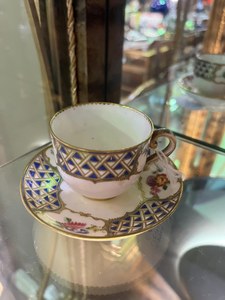In 1756 the Vincennes porcelain factory moved to a new premises in Sèvres at the request of King Louis XV’s mistress, Madame de Pompadour. At the time King Louis XV bought it outright to save it from bankruptcy and it has been owned by the crown and the government of France ever since.
Initiatially soft-paste porcelain was used in production but in 1770, after the discovery of kaolin (the key ingredient for hard-paste porcelain) in France, Sèvres produced both soft and hard-paste pieces until 1804 when the use of soft-paste porcelain was discontinued.
The styles changed from Rococo to Neo-classism to Empire style to Japonism to Art Nouveau to Art Deco. Today Sèvres produces reproductions of popular old models and contemporary creations. It produces items both for the state and commercial sale. Its only two galleries are located in Sèvres and the other in the heart of Paris, in the 1st arrondissement, between the Louvre and the Comédie-Française.
At Ghorbany Benmore we have a pristine Sèvres soft-paste porcelain tea cup and saucer, circa 1760, marked with the Sèvres mark of two interlaced L’s (for Louis XV) with letter G in middle. The pattern of trelliswork decoration was called ‘mosaïque‘ in the Sèvres manufactory’s archives.



